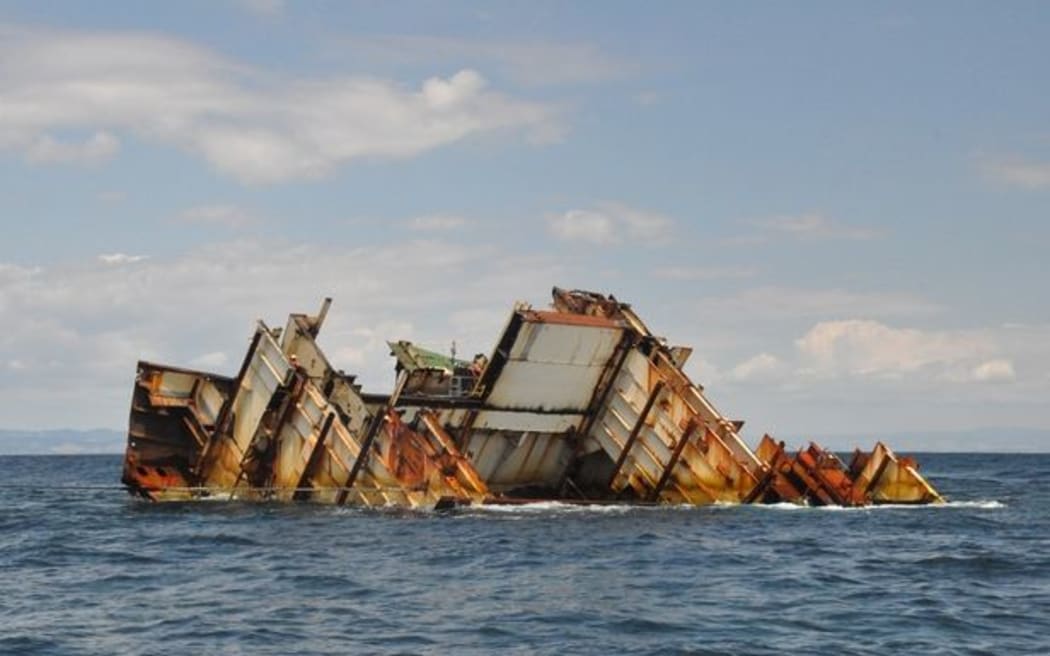A hapu in the Bay of Plenty said the regional council needs to quickly reject an application to leave the wreck of the Rena where it is before more environmental damage happens.

The Rena in April 2013 Photo: RNZ
The owners, Costamare, believe it is too risky to move what remains of the container ship, which grounded off the coast of Tauranga on 5 November 2011, and have formally applied to leave it where it is.
Bay of Plenty Regional Council deputy chief executive Eddie Grogan said the council will take all the time it needs and is allowed to consider the application.
The Rena is continuing to shift after it hit the reef. Ngai Te Hapu spokesperson Buddy Mikaere said every time it does so debris and ongoing leaching of contaminants puts more of the environment at risk.
Maritime New Zealand has a statutory notice in place which declares the ship remains hazardous and a second requiring it to be secured and taken away. Both notices can be changed or removed if resource consent is approved.
A spokesperson for Costamare, Hugo Shanahan, told Radio New Zealand's Morning Report programme on Wednesday a plan is in place to contain any debris or oil which comes from the ship in the next 10 years at the owner's expense.
"If it degrades and breaks up over time, what you are seeing there is a structure that is not going to float. You are talking about heavy chunks of steel. The scope of work the salvers have been focused on has been to remove the potential for any future flotsam."
However, Mr Shanahan said it was possible small amounts of oil might reach the shore as the wreck degrades.
The company earlier said a tropical storm had forced the wreck deeper into the ocean - prompting its request to leave it there indefinitely despite a Maritime New Zealand order hanging over the ship.
The Tauranga community, meanwhile, is standing behind its demand that the Rena wreck be removed. However, mayor Stuart Crosby said the odds are stacked against them.
"It's a bit like taking a knife to a gunfight. We're grossly under-resourced in terms of a community. The insurers, salvers and owners have put together quite a formidable team with a lot of documentation yet to be released."
Mr Crosby said the conditions of any RMA decision to leave the wreck would still need to be clarified, and argued the proposal by the owner to leave the Rena was purely financial.
"They've spent, they claim, between $350 million and $400 million which is a lot of money, probably one of the most expensive wreck removals in world history, and I suspect the insurers are putting incredible pressure on them just to get out."
A Bay of Plenty business owner claiming $25,000 in compensation because his earnings dropped after the grounding plans to support the application to keep the wreck on the reef. Fatboy charters owner Russ Hawkins says the Rena has growth all over it and can't see how removing it will help the ecosystem.
The Bay of Plenty Regional Council says it will open public submissions.
The impact of Lusi
Tropical storm Lusi, which struck the Bay of Plenty in March, changed the position and condition of the wreck, according to a new underwater sonar survey provided to Costamare, and its insurer, the Swedish Club.
The survey, by Roger King of TMC Marine Consultants, said the ship's accommodation section lay in deeper water than before the storm; roughly 20 to 50 metres below the surface.
"The aft section has rotated on the stern, so it is now lying further to starboard and has been significantly weakened, presenting an even greater safety risk and technical challenge for ongoing salvage operations," he said.
Hugo Shanahan said for those reasons they had applied for the resource consent to leave it there.
It is not yet known whether the resource consent application will be heard by the regional council, the Environment Court, or a higher court.
On the upside, the ship's movement has helped expose container and cargo debris that had so far proved too difficult to access; a barge and a new crane will be used to recover debris and part of the ship structure weighing up to 10 tonnes.
Then, a dive team and possibly even a powerful magnet will be brought in to scour the debris area.

The Rena's bow was dismantled in February 2013. Photo: RNZ

